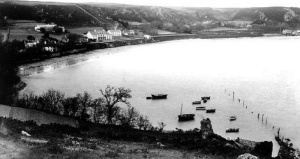Picturesque and a highly popular summer destination, St Brelade's Bay and its beach have proved a big draw for both residents and tourists since the 19th century.
Residents
Research into the history of the bay reveals some fascinating stories as well as identifying a strong association with many famous figures in island history.
Marie Bartlett, nee Mauger, whose money was used to build the General Hospital, is buried in the cemetery with her husband. The internationally renowned surrealist photographer Claude Cahun (Lucy Schwob) is also buried there, only a stone's throw from La Rocquaise, the house in which she and her stepsister Marcel Moore (Suzanne Malherbe) lived. The house dates back to the 17th century, with many original features still surviving.
Tourism
The growth of tourism has clearly been instrumental in the development of the bay as it is today, typified by two of its most iconic hotels. The first of these is St Brelade's Bay Hotel, which was originally called the Pic-nic Hotel, and appears under that name on the Commander Richards military map of the island dating from 1867.
Stead's Picture of Jersey, written in 1809, mentions an inn near the church 'where excellent accommodation will invite the tourist to stay a night'. It is difficult to confirm that this is the same hotel, but research indicates that the Pic-nic Hotel was certainly in existence by the mid-19th century. (Editor's note: The signwriter may have decided that no apostrophe was needed in St Brelades, but used a hyphen in the word not long introduced to the English language from the French pique-nique.)
The story of the hotel took an unusual turn during the Occupation when, while under the ownership of the Colley family, it became a German soldiers' home. Many sketches and poems by German soldiers who stayed there can be found in the surviving guest book held by the hotel.
The second hotel in the bay with an intriguing history is the l'Horizon, which now gives the impression of a mid-20th century building, but dates back to the previous century. Property contracts reveal that it was originally built as a seaside villa on land purchased by Thomas Sutton in 1847. Sutton was a renowned Victorian photographer who move to Jersey. He invented one of the early panoramic lenses.
It was under the chairmanship of George Francis Child Villiers, the ninth Earl of Jersey, that the property was developed into a hotel for the first time in the 1950s.
Refuge
The popularity of St Brelade's Bay, both for tourists and islanders, increased its draw as a place to live, from the Victorian era onwards. It provided a refuge for a prominent French political figure at the site of what are now Chateau des Roches apartments.
The original house was built in the mid-19th century and had various names, including St Brelade's Villa, Pinehurst and Chateau des Roches. In 1889 General Georges du Boulanger stayed there while seeking refuge in Jersey. He was recorded as living there in the 1891 census, with nine servants, including a cook, coachman and gardener. It was his occupancy which led to the house sometimes being called Maison du Boulanger.
The general was born in Rennes on 29 April 1837. After an army career he entered French politics in the mid-1880s and became War Minister. From that point his supporters, often known as Boulangistes, grew rapidly in number. He resigned in protest when his policies were not adopted and was re-elected to the French Chamberof Deputies in 1889. Now he was regarded as a major threat to the Third Republic.
He failed to seize the initiative which might have given him an opportunity to take power, and his opponents in government decided to proceed with a prosecution against him. He fled, much to the dismay of his supporters, staying at Chateau des Roches until the summer of 1891, when he moved to Brussels and committed suicide there in September that year.
Constance Brown
Another person strongly associated with the bay is Constance Brown, who lived above the beach at Mimosa Cottage on Mont Sohier. Following the death of her father, Constance's mother moved to Jersey with her family and bought the cottage on 7 January 1933. At this time it was known as The Hut and shortly afterwards the family built Brown's Cafe on the site of the later Zanzibar Restaurant.
The family continued to run the cafe throughout the Occupation. During their time there Constance was responsible for saving 22 people's lives from the often treacherous currents in the bay. She was also instrumental in the founding of the Jersey Lifeguard Club in 1953, and her services to life saving were formally recognised when she was awarded the MBE in 1967.


